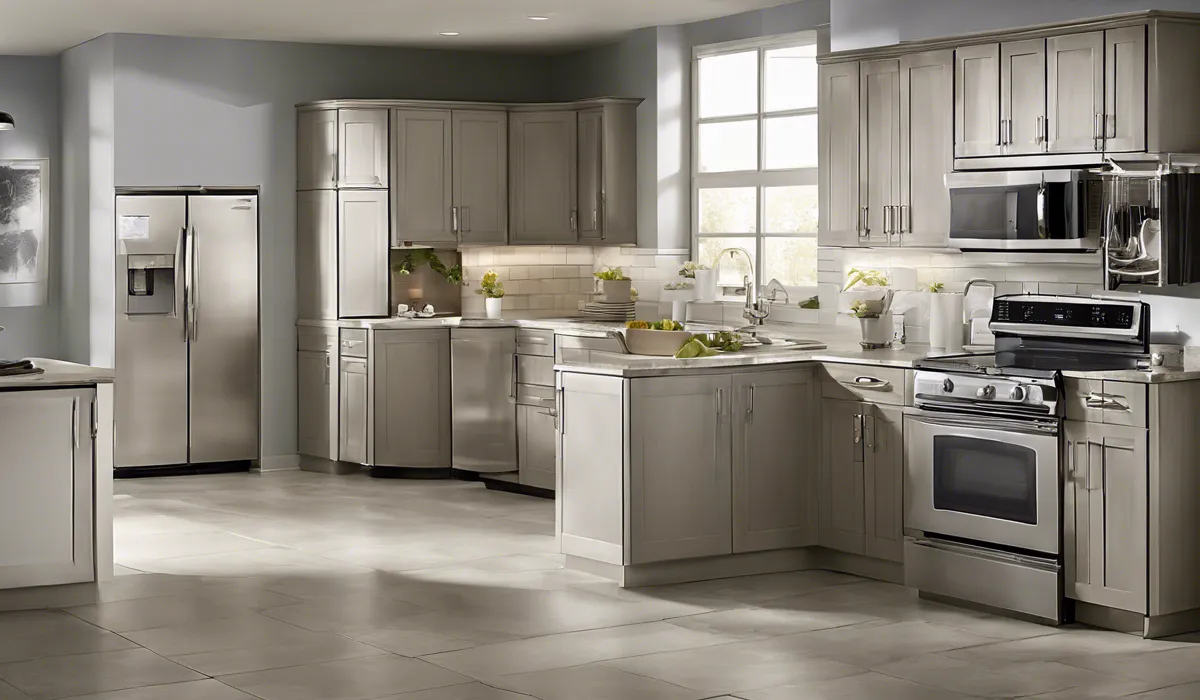What Is a Freestanding Dishwasher? Unveiling the Kitchen Staple
A freestanding dishwasher is a standalone appliance designed for flexibility in kitchen placement. Unlike built-in models, it does not require custom cabinetry for installation. This type of dishwasher can be conveniently relocated and typically offers a standard size and variety of design options to suit different kitchen layouts.
Understanding Freestanding Dishwashers

Definition of a Freestanding Dishwasher
A freestanding dishwasher is a self-contained appliance that offers significant convenience and flexibility in kitchen placement.
It stands alone and does not require being built into kitchen cabinetry or worktops. This versatility is a hallmark of the freestanding dishwasher, making it a popular choice for many households.
Distinction from Built-in and Portable Dishwashers
Unlike built-in dishwashers, which are integrated into kitchen cabinetry for a seamless look, freestanding dishwashers can be placed anywhere with access to water and drainage.
They differ from portable dishwashers that often come with wheels and are connected temporarily to a faucet. Freestanding models provide a more permanent solution without the need for cabinetry modifications.
Advantages of Freestanding Dishwashers
Freestanding dishwashers offer several benefits, including ease of installation, a variety of design choices, and the ability to easily relocate the appliance if necessary.
They are generally more cost-effective than built-in models and can be a practical solution for renters or homeowners who prefer a non-permanent option.
Ideal Situations for a Freestanding Dishwasher
This type of dishwasher is ideal for those who are renting their homes, have not decided on a permanent kitchen layout, or simply prefer the ease that comes with an appliance that can be moved without much hassle.
Freestanding dishwashers are also suitable for people who may move frequently or do not want to invest in custom cabinetry.
Space Requirements and Placement Flexibility
The space needed for a freestanding dishwasher usually corresponds to standard countertop height and depth, providing flexibility in placement.
It requires enough space for the door to open fully and for the user to load and unload dishes comfortably. Placement should be near water and drainage connections to function correctly.
Features and Specifications to Consider

Size and Capacity Options
Freestanding dishwashers come in a range of sizes and capacities to suit different household needs. Standard sizes typically match the dimensions of kitchen cabinets, while compact models are available for smaller spaces.
Capacity is measured by the number of place settings that can be washed at once, so consider your typical load size when choosing.
Energy Efficiency and Water Usage
Modern freestanding dishwashers often feature energy-efficient designs that reduce electricity and water consumption.
Look for models with high energy ratings to save on utility bills and lessen environmental impact. Efficient water usage is also a consideration, with some dishwashers using less water per cycle than others.
Program and Cycle Varieties
Dishwashers come with a variety of washing programs and cycles to handle different levels of soiling and types of dishes.
From heavy-duty cycles for pots and pans to gentle washes for delicate glassware, it is important to choose a model that meets your specific dishwashing needs.
Noise Levels
Noise can be a concern in open-plan living spaces or smaller homes. Freestanding dishwashers are rated by their noise level, measured in decibels (dB). A quieter dishwasher is often preferred, so consider models with lower dB ratings for a more peaceful environment.
Additional Features
Manufacturers offer a range of additional features that can enhance the convenience and functionality of a freestanding dishwasher.
Options such as delay start timers, child locks, and smart technology that allows for remote operation and monitoring add to the user experience.
Installation and Maintenance

Steps for Installing a Freestanding Dishwasher
Installing a freestanding dishwasher is relatively straightforward. It involves positioning the appliance, connecting it to water and drainage, and ensuring it is level for proper operation.
Always refer to the manufacturer’s instructions or consider hiring a professional for installation.
Tips for Ensuring Optimal Performance
To maintain optimal performance of your dishwasher, load dishes according to the manufacturer’s guidelines, use the recommended detergent, and regularly clean the filters and spray arms. Running a dishwasher cleaner periodically can also help keep it in top condition.
Routine Maintenance Tasks
Regular maintenance includes cleaning the filters, wiping down the door seals, and checking for any food particles or debris that may clog the spray arms.
Also, inspecting and cleaning the drain pump and ensuring the water softener (if fitted) has salt will prolong the life of your appliance.
Troubleshooting Common Issues
Should you encounter problems such as the dishwasher not starting, not draining, or leaving dishes unclean, first consult the troubleshooting section of the user manual. Often, simple issues can be resolved without the need for professional help.
When to Call a Professional
If the problem persists or is beyond your expertise, it’s important to call a professional technician.
This is especially true for electrical issues, water leaks, or if the dishwasher is still under warranty, as attempting repairs yourself could void the warranty.
FAQs About Freestanding Dishwashers
What is a freestanding dishwasher?
A freestanding dishwasher is an independent appliance that can be placed anywhere in the kitchen, as it does not require integration with custom cabinetry.
Can a freestanding dishwasher be built-in?
While freestanding dishwashers are designed for flexibility in placement, some models may be adaptable to a built-in setting, depending on their design and the kitchen layout.
Are freestanding dishwashers easy to relocate?
Yes, freestanding dishwashers are relatively easy to relocate compared to built-in models, as they are not fixed to cabinetry or plumbing.
Do freestanding dishwashers come in different designs?
Yes, freestanding dishwashers come in a variety of designs and finishes to complement different kitchen styles and preferences.
What is the standard size for a freestanding dishwasher?
The standard size for a freestanding dishwasher is typically 24 inches wide, but there are also compact models available for smaller spaces.
Final Thoughts
A freestanding dishwasher offers versatility in kitchen arrangement with its standalone design, eliminating the need for custom cabinetry.
It is ideal for those who prefer a portable option that can easily adapt to various kitchen spaces, providing a standard size and multiple design choices to complement different decor styles.




